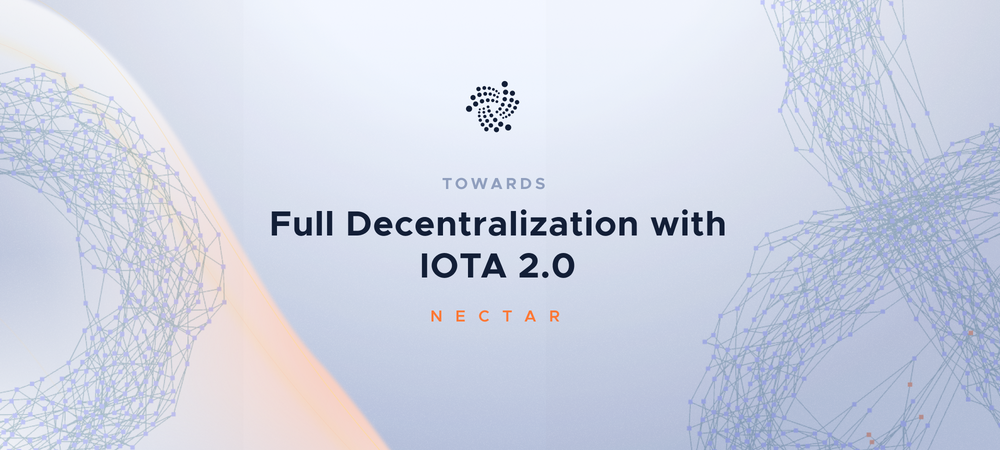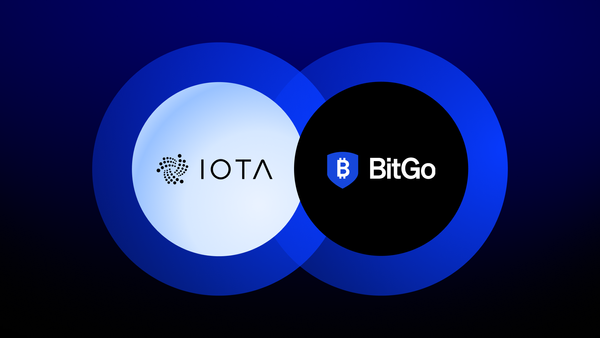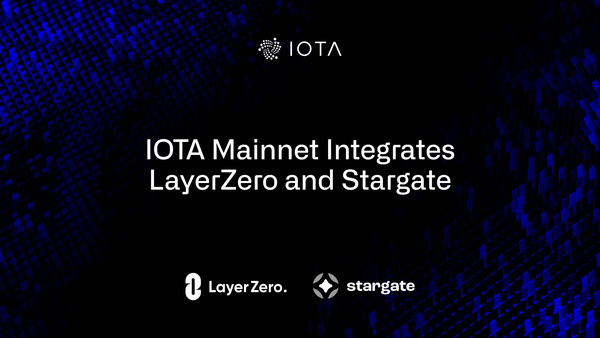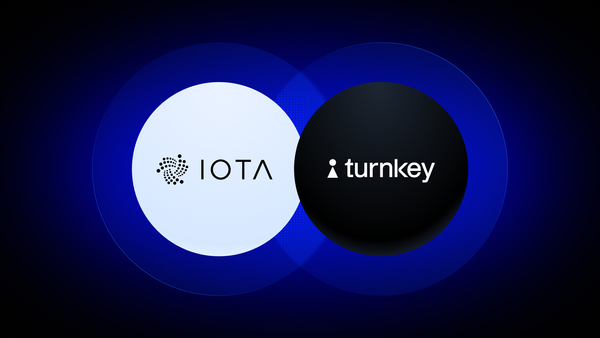Towards Full Decentralization with IOTA 2.0
An update on where we stand to achieve our ultimate goal of full decentralization
The successful completion of the Chrysalis upgrade last month has marked a new dawn for IOTA. After more than a year of extensive development and the successful deployment of the new network, the Foundation together with its ecosystem are confident that the current version of IOTA running in production on the mainnet, is one of the best base protocols in the industry. Nothing has been left untouched. The entire software stack including both node implementations (written in Go and Rust), all client libraries, and the wallet were built from scratch to reflect the magnitude of changes introduced in this new upgrade.
Few projects can claim to have successfully reinvented and engineered an entirely new protocol architecture. It is an immensely complex task to implement and launch a new network with an overhaul of the software stack consisting of tools, libraries, third-party integrations and even a new wallet. In addition to that, the upgrade required us to deploy a secure bridge to transfer assets from the previous (now legacy) IOTA network to the Chrysalis network in a trustless and decentralized way. Nearly $2 billion worth of IOTA tokens were transferred through our decentralized asset bridge between the networks so far, guided by an intuitive and fully automated process within the Firefly wallet.
Looking at all the applied changes, IOTA today is a completely new project:
- A new signature scheme with re-usable addresses (EdDSA) and faster, more secure hashing
- Atomic Transactions which reduced the transaction size from 1.7kb to less than 100 bytes
- Switching to UTXO to allow programmability and scripting of transactions - and preparing the network for the eventual introduction of digital assets on the IOTA mainnet
- Optimizing wherever possible, including the tip selection algorithm, which leads to confirmation times of less than 10 seconds
- And much more
All these improvements introduced with the Chrysalis upgrade have made IOTA a highly performant and easy to use DLT protocol - with a minimal energy footprint and without transaction fees. The upgrade offers our ecosystem a powerful set of tools to build dApps and IOTA-based business models, forming a strong foundation for us to explore new ecosystems, use cases, and opportunities.
One of the most important - and less obvious - reasons, why the Chrysalis upgrade was so crucial is that it offers the IOTA ecosystem a smoother transition to our ultimate goal: the launch of the fully decentralized IOTA network – IOTA 2.0.
Since the project’s inception it has always been our intention to fully decentralize IOTA and deploy a distributed ledger protocol that can scale to support mainstream adoption. With the Chrysalis upgrade complete, we can take a closer look at the road ahead to reaching our target of full decentralization and the removal of the coordinator.
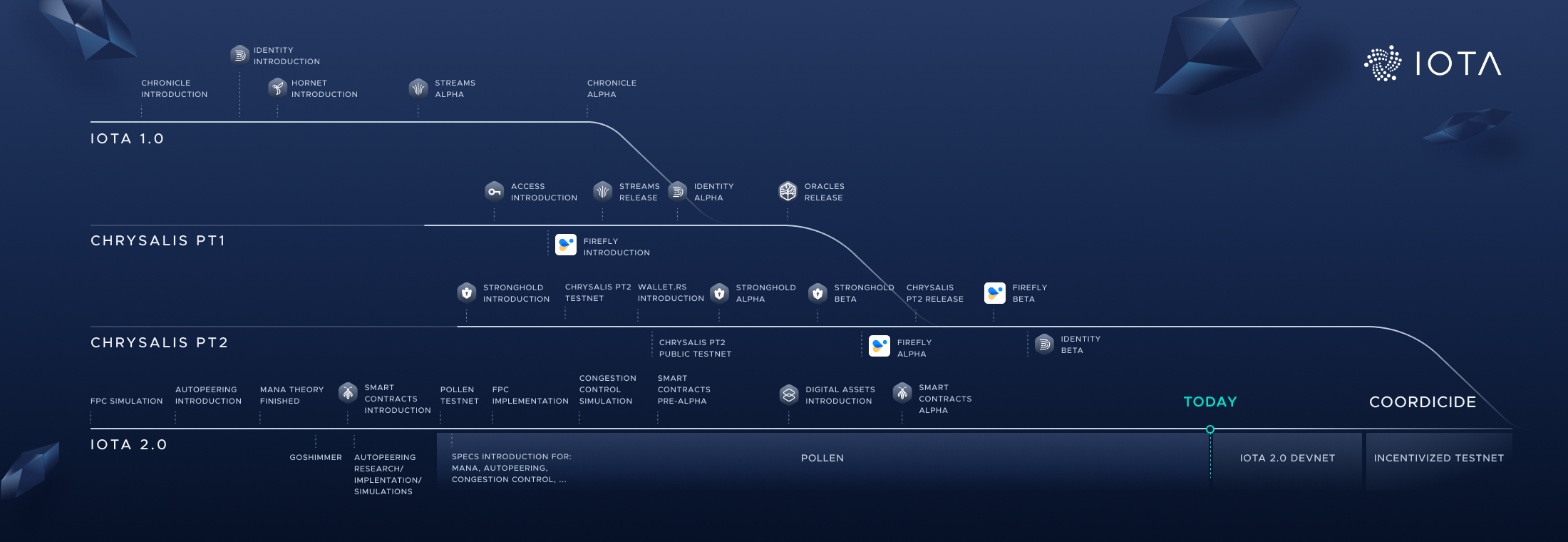
With pragmatism to the most optimal solution
IOTA started with the idea that Directed Acyclic Graphs (DAGs) are better than traditional blockchain architectures, and that a DAG (in our case, the Tangle) can overcome known limitations of blockchain technologies like network congestion, scalability, transaction fees, miners and the excessive waste of energy. IOTA was born to rethink blockchain altogether and achieve mainstream adoption. Instead of just forking the Bitcoin blockchain and changing a few parameters, we were convinced that IOTA would be the ultimate distributed ledger technology, and that it was worth our time, effort and dedication to bring this technology to the market.
The IOTA project was founded with pragmatic principles, and a focus on building and iterating quickly to achieve an (eventual) optimized and proven solution. Today, every blockchain project still has significant flaws that will need to be solved before true mainstream adoption can be achieved. Many of these problems are deeply anchored into the underlying blockchain architecture, which means that they will reside within the core protocol forever. This is the reason why many new, innovative solutions are pushed to Layer 2 in an attempt to overcome scalability and fee limitations on Layer 1.
This pragmatic approach was the reason why we decided to initially launch the IOTA network with a coordinator (a special node in the network which protects it against attacks and assists in the confirmation of transactions). Those training wheels were crucial for the project to get off the ground and to enable us to further innovate on the Tangle concept and the full decentralization of the IOTA network. While other networks gradually move towards centralization (mining oligopolies and stake pools), IOTA is moving towards its full decentralization with every node in the network directly contributing towards the consensus and security of IOTA.
With the launch of the Chrysalis upgrade, the last remaining major improvement of IOTA is the removal of the coordinator. The removal of the coordinator will make IOTA one of the most decentralized, most secure and most scalable distributed ledgers - while also being completely feeless.
This solution is IOTA 2.0, engineered over 4+ years of research, close collaborations with leading universities and experts, dozens of peer-reviewed research papers and months of development and testing together with our community.
The path towards IOTA 2.0 (and Coordicide)
The most exciting, but also the most difficult, phase in building IOTA 2.0 is the transition from research to engineering. It is a challenging task to implement a groundbreaking new DLT solution in code, stitching together the various components to build a functional and secure consensus network. To close this gap, our team built the GoShimmer node, a research-driven implementation of IOTA 2.0 for validating the research concepts and enabling the community to participate in the development of IOTA 2.0.
Nearly a year ago we officially deployed the Pollen network, the first of three phases to bring us towards Coordicide. Our blog post at the time explained how we would reach the removal of the coordinator in three stages: Pollen, Nectar and finally, Honey. The Pollen network has proven a great success in validating, analyzing and improving the IOTA 2.0 solution. However, we realized that we might have created unnecessary problems with our naming allegory and have wrongly set expectations that the path towards IOTA 2.0 is a clear-cut three step process.
Even though Pollen, Nectar, and Honey are great product names, we have learned that simple-to-understand names better reflect the development cycle, consisting of continuous validation, deployment, testing and roll-out. With this in mind, we will move forward in simplifying our terminology, including future software releases.
The upcoming network release will be named IOTA 2.0 DevNet (Development Network). This network will serve as clear proof to the crypto community that a fully decentralized version of IOTA is possible, and that it is superior to existing Blockchain technologies. Although based on a research prototype, the IOTA 2.0 DevNet will be the first fully functional network containing the major components of IOTA 2.0:
- Fast probabilistic consensus (FPC) and approval weight
- Parallel realities based ledger state
- Congestion Control
- Access and Consensus Mana
- Fully functional GoShimmer node
- Exciting new features such as Digital Assets, Aliases, different Output Types and Smart Contracts (in upcoming releases)
The team will work on gradually adding additional features to the network following the official launch:
- Reorg if a node’s local perception differs to the majority of cMana
- Voting on timestamps
- Rate control (i.e. adaptivePoW) and local snapshots
- dRNG committee selection based on consensus Mana
As the name of the network suggests, it is primarily intended to serve as a Development Network. This will help our team to iterate and develop faster, building a more optimized version of the protocol, but also allowing our ecosystem to start developing dApps with features not yet present on the IOTA mainnet (including Digital Assets, NFTs and Smart Contracts).
What’s also new about the IOTA 2.0 DevNet release is that assets on the network will for the first time be persistent. This means that the ledger state and token balances will remain even after network upgrades (Disclaimer: this is still a testnet, so there are no absolute guarantees). Having the IOTA 2.0 DevNet in a state close to the final version of IOTA 2.0 empowers our ecosystem to start experimenting and building on IOTA 2.0 now before the official upgrade of the mainnet. Our goal is to make the transition to IOTA 2.0 as fluid as possible, and already start building the ecosystem, including new dApps, Mana Marketplaces and Wallet Integrations with the launch of the IOTA 2.0 DevNet. Needless to say, we are excited to see what our community will build on the new network.
After the IOTA 2.0 DevNet launch, our team will continue to work on more optimizations and improvements to the protocol and its implementation. Furthermore, we will start to reimplement the components from GoShimmer into production-ready software in Go and Rust (just as we did for Chrysalis in e.g. Hornet, Bee and Firefly). This is an important step to move towards the fully incentivized testnet, and the removal of the coordinator on the IOTA mainnet.
The incentivized testnet is meant to accelerate both the adoption of IOTA 2.0 and the successful removal of the coordinator. Combining participation in the public network with certain incentives will help accelerate bug squashing and battle-test the IOTA 2.0 solution. After carefully looking at the various options to create the incentivized testnet, our team decided to take an alternative approach to accelerate the launch of IOTA 2.0. We are currently preparing this plan and will share it with the community once ready.
The IOTA Foundation cannot wait to enter this next phase on our path towards full decentralization. The IOTA 2.0 DevNet will empower our community to start building the future of dApps already today, and show our critics undeniable proof that IOTA 2.0 is an unstoppable train that has already left the station.
Subscribe to the Newsletter here and receive it directly to your email
Follow us on our official channels and stay up to date with the latest news!

